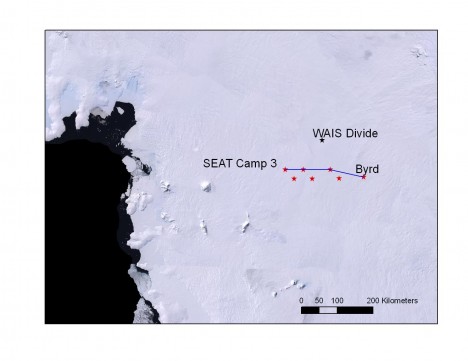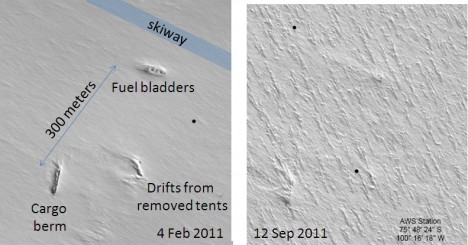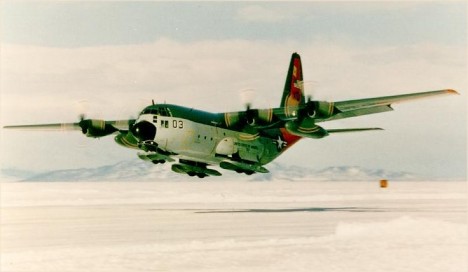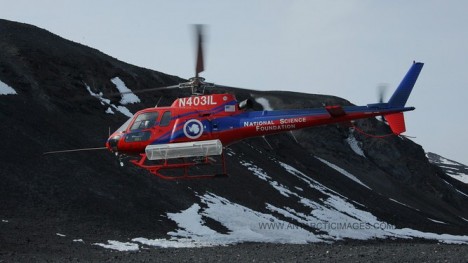

By Bob Bindschadler
McMurdo Station (Antarctica), 28 December — I can’t remember being able to write two good-news messages in a row this entire trip, so I hardly know how to react. On the heels of the successful Twin Otter recce, yesterday’s Herc flight made it to PIG Main Camp. It was scheduled to depart later in the morning to avoid possible fog. As it turned out, there was no fog, but then I had to worry that some other issue would confound the attempt. Taking a pessimistic view seems to be working wonders, because the flight took off early, successfully delivered cargo and camp staff to PIG, and was able to return to McMurdo without even having to refuel. It’s enough to make a scientist superstitious.
The weather continues to hold. That big old high pressure over the middle of West Antarctica is doing a great job and is expected to stay in place through the beginning of the weekend. I spoke with the Guard planner and he said that not only was PIG on their schedule every day this week, but because this weekend is another two-day holiday, they are thinking seriously of scheduling two flights to PIG on Friday. That would be #’s 5 and 6 (assuming success today and tomorrow). And if that wasn’t enough, they are likely going to be raising the ACL (allowed cargo load) so that yet more people and stuff can get out there.
Helos and Otters are in the offing, as well. The first of the helicopters will be “taken down” this evening. This means they will start to disassemble it (blades, rotor, skids and half the transmission come off), so it can squeeze into the Herc cargo bay. It might be ready for a Friday flight to PIG. The second helo would be a day behind. Meanwhile, Otter schedules are being reviewed so NSF can decide what Otter could come to PIG and how long it could stay.
All these developments have led to a whole new series of talks with various players here that have taken on a noticeably different tone. The cargo sequencer is telling us that we should be ready to fly out to PIG as early as Friday. After so many delays and the increasingly dark cloud that had grown over the project, the sudden change is like being hit with a bracing bucket of cold water. Suddenly it is time to start moving again!
The rest of this week will either see us break the back of the delays, or it will likely end the project for this season. Spirits are extremely high.
By Lora Koenig
McMurdo Station (Antarctica), 15 December — Today the Traverse Team traveled from SEAT Camp 2 to SEAT Camp 3. They picked up their fuel cache at Camp 3 and enjoyed the chocolate chip cookies that were inside. So far, the team has drilled three ice cores and traveled over 220 kilometers (136.7 mi). They will be at Camp 3 for at least two days to drill two ice cores in this area, which is the highest accumulation site on the traverse. The accumulation here will be close to 1 meter (3.28 feet) per year, while at Byrd is was over10 centimeters (3.9 inches) per year. The team is traveling fast and making up lost time each day.

I am in McMurdo, waiting for a plane to fly back to Christchurch, New Zealand. The plane will arrive shortly after 4 AM. The C-17 planes have to land in the middle of the night because the days are already too warm, and the ice on the runway too soft, for a plane to land during daylight. So they are landing in the wee hours of the morning, which corresponds to the coldest part of the day and the hardest ice conditions. Once I get on a plane, I will be in transit for 60 hours, until I reach my home in Maryland.
I will leave Antarctica on the same plane than the Prime Minister of Norway, who was just at the South Pole to celebrate the 100th Anniversary of Ronald Amundsen being the first man to reach the South Pole. Our traverse team is still following in Amundsen’s footsteps, traveling over the ice to gain a better understanding of Antarctica.
By Lora Koenig
Byrd Station (Antarctica), 13 December — Well, I am still at Byrd Camp. One plane for the day from McMurdo has already been canceled and two more are scheduled. Byrd has not had a flight in over a week, and they are trying to get as many flights from McMurdo in as they can. There are still science teams waiting to get here. Also, the camp would like some freshies (fruits and vegetables), to increase moral. I shoveled some more today for the camp and did some house mouse choirs, which included doing the dishes, sweeping, and washing the tables. I may as well stay busy while I am waiting.
The team is traversing to Camp 2 today. They finished the ice core at Camp 1 and all the science is going well. When I last spoke with them, they were going out to locate their fuel cache, so they will have a nice loaf of bread to have with dinner tonight.
I just heard that my plane is in route, so I just may get to McMurdo tonight.
By Bob Bindschadler
McMurdo (Antarctica), 16 December — It was just weird. The Herc mission to land the put-in team at PIG had become a daily mainstay of the schedule I saw on the TV monitor as I walked into breakfast every day for the past week. Sometimes the cancellation came before breakfast was finished, sometimes I was able to carry my hope with me as I left the cafeteria. If the forecast suggested currently poor, but gradually improving conditions, they would hold the mission back until the weather picture became more certain. To date, certainty usually shifted toward deteriorating conditions at either PIG or Byrd (the required refueling camp) leading to yet another cancelled mission.
Tuesday the mission actually launched, the PIG webcams showed gorgeous weather there and many in town held their collective breath. It was the topic at lunch—the flight was two hours out, three more to get to PIG and still heading the right direction. Unfortunately, a short time later word came back that the forecast for Byrd was getting worse. The refuel camp was changed to the WAIS camp, roughly 100 miles away, where the forecast was better. But soon thereafter, the WAIS forecast worsened and the mission was ordered back home. The poor folks on the plane ended up flying for five hours and got off the plane at exactly the same spot where they boarded—McMurdo—still no closer to PIG.
Wednesday’s mission tore at the heart even more. It was a good weather trifecta—sunny at McMurdo, PIG and Byrd. Mission off-deck at 0931, ETA at PIG by 1400 (2 PM). Forecasts remained good at all sites and we constantly updated our webcam links hoping to witness a successful landing. It never happened. Limited information came to me, but the most important info was clear—they had not landed and were returning to MacTown with everything and everyone still on board. I couldn’t believe my ears. Having learned from past field experiences to set aside my emotional reactions right away, I discussed the possible explanations with the head of the Herc squadron. Maybe they had the wrong coordinates? Coordinates can get confused because some use degrees, minutes and seconds, some use degrees and decimal degrees, while even others favor degrees, minutes and decimal minutes. You’d be surprised at how often this happens and how much this can matter. I checked with a mapping support person who could download spectacular two-foot resolution images of the area taken both as the camp was left last February and how it looked this September (see the pictures below). Knowing I had the right coordinates, I rushed back to Herc operations to see if I could redirect the plane if they had gone to the wrong spot. Radio communications with the plane weren’t great, but good enough to hear that they saw features that told them they were, in fact, at the proper spot. Details would have to wait for their return.

They came back very late, with the delays of having to refuel at Byrd and then debrief and take the long ride back to town from the ice runway (now nearly an hour-long, bone-jarring ride). Still no word by dinner, I sat with the Herc commander, Mark Sakadolsky, just to be sure to get as close as I could to any information. He’s a friend from past seasons here together and an easy guy to talk to. Everyone in town knew the plane had reached PIG, found the weather excellent, yet turned around without landing. There were lots of ideas why; McMurdo is well known to be a fertile rumor mill. I didn’t get the official word from Mark (and Charles Kirkland, who will be the PIG Main Camp manager) until the next morning. There were large sastrugi (snow dunes) crossing the old skiway. The pilots couldn’t see many skiway markers; most were buried under the 1.5 meters (5 ½ feet) of snow that has accumulated since last season, but they could orient themselves well enough relative to the drifted cargo berm and fuel bladders to know where the skiway had been. Landing that direction made little sense because they would have chattered their way across numerous sastrugi, possibly damaging the plane. (I’ve been there, done that, and don’t want to do it anymore, so this was a wise decision). Their next option was to land parallel to the sastrugi and although they received permission to do this, as they lined up on their final approach and had their skiis nearly touching the tops of the sastrugi, they decided the sastrugi were just too big to land safely. So they got close, really close, literally a few feet from landing. I’m not sure if I want to call that progress or not.
For those of you following this saga, you know that this story is being written with many subplots. So you may ask “and what of the traverse?” Good question! The traverse has been lumbering onward and may arrive tonight! Their imminent arrival figured strongly into the Guard’s decision to forego any further PIG missions until the traverse party has a chance to unhitch their heavy machinery and use the skiway groomer (left in the PIG cargo line) to level those dangerous sastrugi and prepare a smoother landing strip before the next Herc arrives. The additional benefit of having the traverse there is that the “fuelie” (definition: a person who handles fuel lines, fuel drums and fuel bladders, responsible for fueling vehicles and planes) can tap into the 27,000 gallons of fuel there to refuel visiting Hercs directly, removing the need for that troublesome third camp refueling stop for PIG flights. Thus, we are on the verge of a much-improved situation for getting cargo and people to PIG. If this is an early Christmas present, I’ll take it—even without the bows and wrapping paper.
So Thursday became was a strange day. No PIG mission on the schedule. The only project contribution I could make was to transmit positive vibes to the traverse party. Nothing broke or slowed them down, so maybe it worked. I also kept talking to some of the key people here. I suggested to Mark that for every day we don’t have a mission, I want him to think of us banking one for a later date. I tried (unsuccessfully) to convince the Guard and the National Science Foundation (the institutions that manage U.S. Antarctic operations and logistics) to increase either the number of planes or crews that would operate during the two-week holiday slowdown. Numbers are reduced from six planes and six crews to three planes and four crews and an extra no-fly Saturday for Christmas and another for New Year’s is added to the cast-in-stone no-fly Sunday. These are massive reductions in capacity. I have complained for 30 years about this (along with many other deep field scientists), to no avail. Call me Mr. Scrooge or The Grinch if you like, but this is Antarctica. We have a limited amount of time to work in the “deep field” so we can answer questions being put to me in Congress and by governments around the world. Check your holiday spirit when you pass south of 60 degrees south latitude! Our holiday comes when we go home. Deep field camps don’t have holidays unless bad weather affords them the luxury. (Grrrrr!)
The other unusual thing about Thursday was the visit of the Norwegian Prime Minister, Jens Stoltenberg. As I’ve written before, I had already met with his advance committee. The Prime Minister shot through McMurdo very fast so he could ski the last 10 km to the pole with a group of 4 Norwegians (who had skied the entire Amundsen route) and arrive at the South Pole exactly 100 years after Amundsen. He had two hours to see McMurdo on his way back north and I was asked to prepare a short presentation on the PIG project. His schedule was delayed by South Pole weather so he never made it to the science lab and never saw the poster (but you can—it is posted on our project’s web site). Better than the short presentation I couldn’t give was the fact that I was invited to join the PM at a dinner being hosted at Scott Base by the New Zealanders. To make sure that I had the chance to discuss my project with Jens, I was seated directly across the table from him and next to his Executive Secretary. I took advantage of the arranged seating and had a very engaging conversation with him. Norway is very proactive in responding to climate change. I was as impressed with the variety of steps he described Norway is taking as he was with the science of climate change and the importance of our particular piece we are trying to accomplish on the PIG ice shelf this season. Jens and Ron (the Scott Base manager) gave speeches (very good speeches, actually). Ron surprised Jens by offering him an après-dessert helo ride to both Cape Evans and Cape Royds where huts remain from Scott’s and Shackleton’s polar runs. I have no idea when they returned; I took an earlier ride back to MacTown to sleep, arriving at midnight. Prime Ministers don’t sleep much.
An extra surprise for me that evening was to see Jan Gunnar Winter with the Norwegian delegation. Jan Gunnar is a colleague and a friend I have known for many years, and he’s presently the director of the Norsk PolarInstitut. I didn’t know that he was one of the 4 skiers repeating Amundsen’s historic journey. His face was weather-beaten and he had some gripping stories to tell of their expedition. All of Norway seemed to be following them via daily broadcasts by the skiers—Amundsen had dogs to help him, these 4 had the extra burden of reporting to their countrymen every night and a deadline to keep. Jan Gunnar has become a national celebrity, but he was most looking forward to a week-long vacation in Thailand with his wife. No one has ever deserved this reward more. I’ll take the easy route and fly to PIG.
By Bob Bindschadler
McMurdo (Antarctica), 14 December — (Warning: this entry is not for the weak of heart.) Woe is me. A logistics scourge seems to have befallen our project. The past two days have been filled with nothing but bad news. The traverse from Byrd to PIG not only has continued to encounter soft snow, but the transmission on one tractor has failed, and a hydraulic line on another one has a leak that has stopped it literally in its tracks. Much of the cargo being hauled by the tractors is loaded on sheets of very slippery, but strong, plastic. Well, maybe not so strong, after all: This is the second season these sheets have been used and they are starting to crack and break, forcing the traverse party to stop, jigger the load around and then start up again. All this leaves me with the mental image of bits of the traverse littering the trail from Byrd to PIG. Still, the traverse people press onward, with fewer vehicles and less cargo. Their estimate is to arrive at PIG on Friday, but unless they cover more than the 20 miles they’ve completed each of the past two days, it will take yet longer.
The flying side is not going much better. Bad weather continues to plague both of the possible refueling stops so the put-in flight has been cancelled every morning. The weather is forecast to improve at those sites, both of them in the interior of West Antarctica, but (you guessed it) weather at PIG is deteriorating now. We in the field party marooned in McMurdo test our mental mettle by checking a couple of web sites that allow us to view the weather forecasts for the key stations involved in this effort, as well as David Holland’s web cam, which remains our lone virtual presence at PIG. It hurts to see sunny skies there and not be able to fly a plane there.
If this was a football game, the cargo managers would receive a penalty for “piling on”. Yesterday we had a meeting where we heard that our cargo was not the 9,000 pounds that we had planned, but rather 15,000 pounds, necessitating an additional flight to PIG (#9, if you are keeping count). We were only slightly surprised, because I saw this coming. In fact, I was the one who asked for the meeting so we could address any problem early. As I explained in my previous post, we’ve had to add a number of items to our cargo line due to less being taken by the traverse. Also, our colleague Sridhar Anandakrishnan was sent to his early season work site without the skidoos he was supposed to use there, so we have to bring them to PIG via another route. I felt it was time to push back on the size and design of the PIG Main Camp. I said we would lower the priority of some limited parts of our project, so they could arrive on this later flight, but I couldn’t shed all of the 6,000-pound extra cargo. I insisted on some sacrifices from the Main Camp. The head of construction there offered to consider downsizing some of the plumbing (!) and electrical components of the camp. Most others didn’t offer much. If the Herc pilots like the runway when they get to PIG, they might increase the allowed cargo limit (ACL) of subsequent flights, so this problem might go away, but this strikes me as wishful thinking. Nevertheless, I’ll be meeting with the head of the LC-130 squadron to discuss the benefits of even a 500-pound increase of the ACL. Exploring every possible way of getting us to PIG sooner is what my job here has become.

In that vein, I’ve come up with yet another strategy to recover some lost time. It involves having a Twin Otter airplane attempt a landing at our intended drill camp location on the ice shelf. This is a bit of déjà vu because three years ago I landed on the ice shelf in a Twin Otter only to be told the surface was too hard and rough for repeated landings. Some super high-resolution satellite imagery suggests to us the result might be different at this new site, so I want to try it again.


I’ve had to write to my program manager back in DC to ask that he supports this request. I made the case that, if successful, we could get the drill camp up and running before helos arrive and are operational at PIG Main Camp. We still have work to do that only the helicopters can support, but we are feeling the increased time pressure of time and splitting the support load would definitely help. It could also eliminate the need for any helicopters next season if we can complete the helo-only work this year and the drilling can be supported by Twin Otters. I delivered my sales pitch to the Twin Otter pilots after lunch today, and I’ll hear from NSF back in DC tomorrow.
On the bright side, I have plenty to restore a balanced perspective. Today is the 100th anniversary of Roald Amundsen’s arrival at the South Pole. As everyone surely knows, Robert Falcon Scott and his field party reached the same spot a month later, but perished on the return journey. I am not about to set out to ski/man haul our cargo to PIG, nor I expect to suffer the extraordinary hardships of either Scott or Amundsen. Antarctic science nowadays is usually hard, often frustrating, but it is rarely life threatening. I’ll take that as some much needed good news.